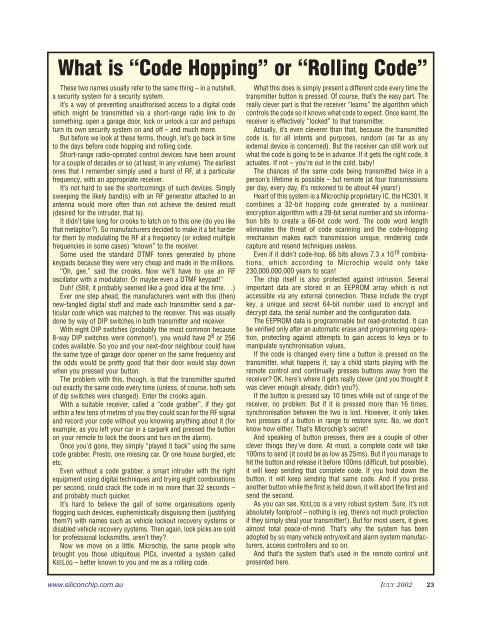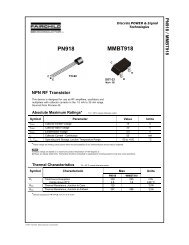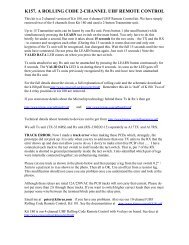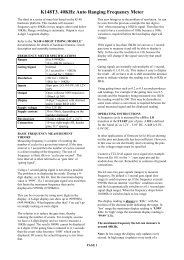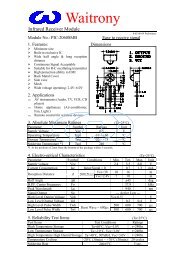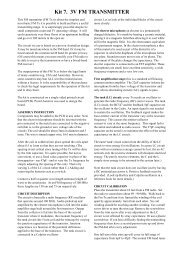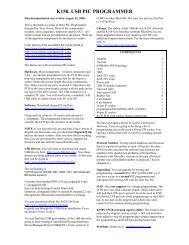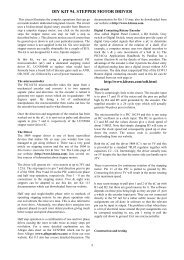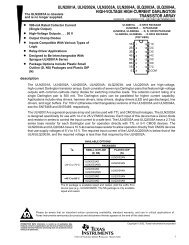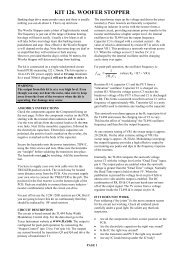A Rolling Code 4-channel UHF Remote Control - Kitsrus
A Rolling Code 4-channel UHF Remote Control - Kitsrus
A Rolling Code 4-channel UHF Remote Control - Kitsrus
You also want an ePaper? Increase the reach of your titles
YUMPU automatically turns print PDFs into web optimized ePapers that Google loves.
What is “<strong>Code</strong> Hopping” or “<strong>Rolling</strong> <strong>Code</strong>”<br />
These two names usually refer to the same thing – in a nutshell,<br />
a security system for a security system.<br />
It’s a way of preventing unauthorised access to a digital code<br />
which might be transmitted via a short-range radio link to do<br />
something: open a garage door, lock or unlock a car and perhaps<br />
turn its own security system on and off – and much more.<br />
But before we look at these terms, though, let’s go back in time<br />
to the days before code hopping and rolling code.<br />
Short-range radio-operated control devices have been around<br />
for a couple of decades or so (at least, in any volume). The earliest<br />
ones that I remember simply used a burst of RF, at a particular<br />
frequency, with an appropriate receiver.<br />
It’s not hard to see the shortcomings of such devices. Simply<br />
sweeping the likely band(s) with an RF generator attached to an<br />
antenna would more often than not achieve the desired result<br />
(desired for the intruder, that is).<br />
It didn’t take long for crooks to latch on to this one (do you like<br />
that metaphor?). So manufacturers decided to make it a bit harder<br />
for them by modulating the RF at a frequency (or indeed multiple<br />
frequencies in some cases) “known” to the receiver.<br />
Some used the standard DTMF tones generated by phone<br />
keypads because they were very cheap and made in the millions.<br />
“Oh, gee,” said the crooks. Now we’ll have to use an RF<br />
oscillator with a modulator. Or maybe even a DTMF keypad!”<br />
Duh! (Still, it probably seemed like a good idea at the time. . .)<br />
Ever one step ahead, the manufacturers went with this (then)<br />
new-fangled digital stuff and made each transmitter send a particular<br />
code which was matched to the receiver. This was usually<br />
done by way of DIP switches in both transmitter and receiver.<br />
With eight DIP switches (probably the most common because<br />
8-way DIP switches were common!), you would have 2 8 or 256<br />
codes available. So you and your next-door neighbour could have<br />
the same type of garage door opener on the same frequency and<br />
the odds would be pretty good that their door would stay down<br />
when you pressed your button.<br />
The problem with this, though, is that the transmitter spurted<br />
out exactly the same code every time (unless, of course, both sets<br />
of dip switches were changed). Enter the crooks again.<br />
With a suitable receiver, called a “code grabber”, if they got<br />
within a few tens of metres of you they could scan for the RF signal<br />
and record your code without you knowing anything about it (for<br />
example, as you left your car in a carpark and pressed the button<br />
on your remote to lock the doors and turn on the alarm).<br />
Once you’d gone, they simply “played it back” using the same<br />
code grabber. Presto, one missing car. Or one house burgled, etc<br />
etc.<br />
Even without a code grabber, a smart intruder with the right<br />
equipment using digital techniques and trying eight combinations<br />
per second, could crack the code in no more than 32 seconds –<br />
and probably much quicker.<br />
It’s hard to believe the gall of some organisations openly<br />
flogging such devices, euphemistically disguising them (justifying<br />
them?) with names such as vehicle lockout recovery systems or<br />
disabled vehicle recovery systems. Then again, lock picks are sold<br />
for professional locksmiths, aren’t they?<br />
Now we move on a little. Microchip, the same people who<br />
brought you those ubiquitous PICs, invented a system called<br />
KEELOQ – better known to you and me as a rolling code.<br />
What this does is simply present a different code every time the<br />
transmitter button is pressed. Of course, that’s the easy part. The<br />
really clever part is that the receiver “learns” the algorithm which<br />
controls the code so it knows what code to expect. Once learnt, the<br />
receiver is effectively “locked” to that transmitter.<br />
Actually, it’s even cleverer than that, because the transmitted<br />
code is, for all intents and purposes, random (as far as any<br />
external device is concerned). But the receiver can still work out<br />
what the code is going to be in advance. If it gets the right code, it<br />
actuates. If not – you’re out in the cold, baby!<br />
The chances of the same code being transmitted twice in a<br />
person’s lifetime is possible – but remote (at four transmissions<br />
per day, every day, it’s reckoned to be about 44 years!)<br />
Heart of this system is a Microchip proprietary IC, the HC301. It<br />
combines a 32-bit hopping code generated by a nonlinear<br />
encryption algorithm with a 28-bit serial number and six information<br />
bits to create a 66-bit code word. The code word length<br />
eliminates the threat of code scanning and the code-hopping<br />
mechanism makes each transmission unique, rendering code<br />
capture and resend techniques useless.<br />
Even if it didn’t code-hop, 66 bits allows 7.3 x 10 19 combinations,<br />
which according to Microchip would only take<br />
230,000,000,000 years to scan!<br />
The chip itself is also protected against intrusion. Several<br />
important data are stored in an EEPROM array which is not<br />
accessible via any external connection. These include the crypt<br />
key, a unique and secret 64-bit number used to encrypt and<br />
decrypt data, the serial number and the configuration data.<br />
The EEPROM data is programmable but read-protected. It can<br />
be verified only after an automatic erase and programming operation,<br />
protecting against attempts to gain access to keys or to<br />
manipulate synchronisation values.<br />
If the code is changed every time a button is pressed on the<br />
transmitter, what happens if, say a child starts playing with the<br />
remote control and continually presses buttons away from the<br />
receiver? OK, here’s where it gets really clever (and you thought it<br />
was clever enough already, didn’t you?).<br />
If the button is pressed say 10 times while out of range of the<br />
receiver, no problem. But if it is pressed more than 16 times,<br />
synchronisation between the two is lost. However, it only takes<br />
two presses of a button in range to restore sync. No, we don’t<br />
know how either. That’s Microchip’s secret!<br />
And speaking of button presses, there are a couple of other<br />
clever things they’ve done. At most, a complete code will take<br />
100ms to send (it could be as low as 25ms). But if you manage to<br />
hit the button and release it before 100ms (difficult, but possible),<br />
it will keep sending that complete code. If you hold down the<br />
button, it will keep sending that same code. And if you press<br />
another button while the first is held down, it will abort the first and<br />
send the second.<br />
As you can see, KEELOQ is a very robust system. Sure, it’s not<br />
absolutely foolproof – nothing is (eg, there’s not much protection<br />
if they simply steal your transmitter!). But for most users, it gives<br />
almost total peace-of-mind. That’s why the system has been<br />
adopted by so many vehicle entry/exit and alarm system manufacturers,<br />
access controllers and so on.<br />
And that’s the system that’s used in the remote control unit<br />
presented here.<br />
www.siliconchip.com.au<br />
JULY 2002 23


